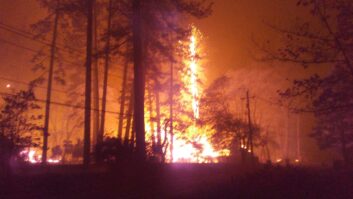
Photo: iStockphoto/Nick M. Do
A friend of mine of 44 years, Rich Walston, spent most of his professional life as a New York City fireman. We met as project engineers in the military. His scope of work was the firing area of the Nike missile system; mine was the integrated fire control which included the radars, computers, etc.
Working in parallel and integrating the two mission areas into functionality, we spent a lot of time together and cemented a lifetime friendship.
In discussing his firefighting work in New York, he tells us that in a populated area that dense, response time is absolutely critical to minimize loss of life and property and to limit the scope of the event. Literally a minute’s delay can mean the difference between a building or a block of conflagration devastation.
From his own experiences and a review of the 200-year history of the FDNY, Rich feels that their emergency response was almost always without exception when someone else failed to follow or meet standards and/or plain common sense.
Building code enforcement was a major contributor. People’s greed in stealing gas service, disabling fire alarm systems, poor grease and cooking hygiene are ready examples. But sometimes a fire was caused by plain stupidity — cooking with a barbeque in a tenement kitchen, using gasoline as a solvent indoors. Sometimes his crew felt there was no limit to the insanity they encountered.
The lunacy is somewhat amusing perhaps because it applies only to someone else in a far distant country called New York City. But does it ?
Let’s go into introspective mode here … When was the last time you checked the charge on all fire extinguishers in your station … the functionality of the fire alarm systems, the operation of all the ground fault interrupters (GFIs), the batteries in the emergency lighting (will they last 20 minutes, do they show the way to an exit), the functionality of the breakaway bars on emergency fire exits, the currency of the exit plans on the walls of every room (did the new studio construction or racks cause a re-routing or close-in a fire exit).
http://www.otenmaritime.com/firefighting/fire-extinguishers/fire-extinguisher-chart Fire Prevention Week, Oct. 7–13, 2012
The Federal Emergency Management Agency and the U.S. Fire Administration, along with the National Fire Protection Association, encouraged individuals and families to have a fire escape plan, noting that hundreds of thousands of fires happen in American homes each year.
In 2010, a total of 362,100 residential fires resulted in 2,555 deaths, 13,275 injuries and more than $6.6 billion in property loss, according to an announcement.
FEMA officials called on people to check that all smoke alarms work. (The USFA recommends that residences be equipped with both ionization and photoelectric smoke alarms or dual-sensor smoke alarms.) Make sure there are two ways out of every room; create a fire plan for your home; and practice with family members.
Related:
Top Fire Safety Questions Your Business Should Be Able to Answer ‘Yes’ (Motley Fool)
While reviewing these exit plans, think about pragmatics. How many cubicles do you need to crawl past to get out? You don’t want to crawl yourself into a corner. Many stations have “Star Trek” doors to limit sound exchange. Do motion sensor doors open on fire alarm or will they lock station personnel in a fire space?
Several times while doing due diligence work, I have discovered that as a cost measure, an alarm service has been terminated. This may be acceptable for theft considerations but it also cut off the fire alarm calls. The station and personnel could be cinders before some passerby would have alerted the fire dispatch.
Check your fire insurance; coverage may actually be predicated on an automatic emergency fire alarm and call system being in place and operational.
Fires and stupidity. My two favorite broadcast stories in that area:
One: On a station inspection for the owners, I came upon a mountain of 50 boxes of copypaper at the end of a hallway, blocking the fire exit at that side of the building tighter than King Tut’s Tomb. I told the GM that these had to go right away; his response was that no one ever used that exit. We had harsh words. I told him I would personally cart the boxes out into the rain if these were not redistributed elsewhere in the building. He bought all these because they were a great price.
Two. On another due diligence trip I found wire ties permanently fixing fire extinguishers to the wall. Why? The staff were afraid the extinguishers would be stolen. My question: Has one ever been stolen without wire ties? The answer, no daaaahhhhhhhh.
At another station I discovered “required extinguishers” on far walls, located behind gear where no one could see them or know they were there. I had to explain to people that to be able to fight your way into a fire, you start at the escape exit. If you had to go to a far wall, you’d be fighting your way out and problematic if you’d make it. These safety devices should be near the doors.
They said they didn’t want to relocate them as it messed up the décor. DUMB.
In general, two things will burn in your station: physical material (wood, plastics, paper, etc.) and the gasses released in the heat.
Your first line of response to any fire is the fire extinguishers in the space. These units are usually hand-held, dry type and directional in dispersal. They come in ratings that match the four categories of fire types. See the useful chart, in the window at the bottom of this story, from the website of the U.S. Fire Administration.
Given the flammable material and gasses that might be present in a station fire, the readily available combination type A, B and C should be viewed as a minimum. A,B,C and E are best.
As critical as the ability to squelch a fire are two other important qualities: distance that the extinguisher can spray/reach, and the duration of discharge.
Engineers are differentiated from other mere mortals because they think better with more clarity and precision, so let’s put that talent to work and reflect on this. Break out of your normal complacency and think about the worst that can happen.
For example, your server room is 15 by 10 feet and has seven loaded racks in the space and a half mile of cable. One of those little boutique extinguishers meant for stovetop grease fires is not going to handle any issue in your server room. A couple of big multi units just outside the door should be the minimum. Also with the investment of seven racks of gear, it really is time to consider automatic fire suppression.
When a fire appears, sound the alarm to all personnel first so they can get out. Next summon the fire professionals. Then consider the fire.
If you must enter a fire environment, fight your way into it to extinguish or slow the spread of the fire. The fundamental idea is always to keep the fire in front of you and escape behind you. If the smoke is so thick you cannot see the flames, back out. Fire is often silent or masked by other mundane noises. The fire could be creeping up your pants legs before you would notice it in the panic of the moment.
I have had only one close encounter with a fire, and that was enough. Most surprising to me was how fast, how incredibly fast, the environment filled with smoke. To breathe and to see anything, you’re immediately crawling on the floor. From my vantage point as an electrical contractor, and given the now minimal costs of LEDs, I firmly believe that public places similar to airplanes should have crawl strips on the floor to take you out safely (a great new business for rug installers). This is more logical than wall-mounted fixtures that are mainly pro forma and often useless in a fire, although helpful in a power failure when they work.
In a station, income may be the dominion of the sales department, ratings start with programming. But safety is everyone’s responsibility.
Get out from behind your desk or bench and walk through your plant. Are you absolutely certain that those pull stations work? Are the batteries in standalone smoke alarms actually functional? Many radio stations are unmanned for large portions of the day and vacant throughout the weekend. No one is around to help the low battery warning. How about the gel battery in your central system? Push the test button and check. Confirm on the maintenance tag that it actually has been serviced in the last six months. How about those old flickering fluorescent fixtures? Ballasts in these fixtures if ignited usually create acrid black smoke. You don’t need the local fire department axing away into your station because the fire alarm had triggered on smoke. Replace with new.
How about the use of electrics in your station? Have wannabe techies installed cascaded plug adapters with a myriad of cheap nation gear under their desks just itching to light up your highly flammable rugs?
As your check out your plant touch every heat generator repeating the mantra: Warm is ok, hot is not.
How about that big new neon sign behind reception? Where are the supplies, are they properly ventilated and are they listed or something the sign shop just threw together.
Finally after you’ve done your review, run your plan through the final filter. Imagine that your loved ones lived in this space. Is there anything left that you would change to reduce fire danger and enhance safety? What would you correct? Then take action.
Charles “Buc” Fitch, P.E., CPBE, AMD, is a frequent contributor to Radio World.
Send your own safety suggestions to [email protected].












